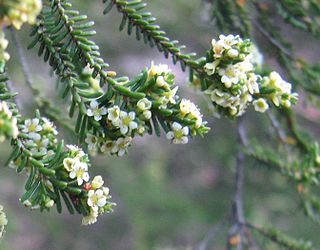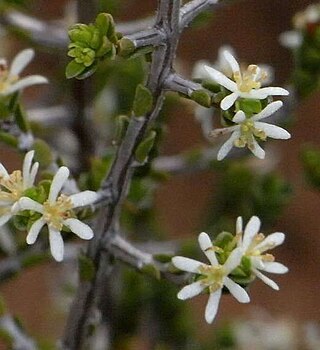
Micromyrtus is a genus of flowering plants in the family Myrtaceae and is endemic to Australia. Plants in the genus Micromyrtus are shrubs with simple leaves arranged in opposite pairs, and white, pink or yellow flowers arranged in upper leaf axils, the flowers with five sepals five petals and five or ten stamens.

Micromyrtus ciliata is a species of flowering plant in the family Myrtaceae and is endemic to south-eastern continental Australia. It is a spreading to erect shrub with crowded, oblong to egg-shaped leaves and small white or pink flowers arranged singly in upper leaf axils, forming clusters on the ends of branches.

Baeckea imbricata, commonly known as heath myrtle, is a species of flowering plant in the family Myrtaceae and is endemic to eastern Australia. It is a shrub with elliptical to egg-shaped or round leaves and small white flowers with five to twelve stamens.

Micromyrtus sessilis is a species of flowering plant in the myrtle family, Myrtaceae and is endemic to eastern Australia. It is a dense, spreading shrub with small, more or less linear leaves and flowers that are sometimes single in the upper leaf axils or in dense clusters along the branches. It is similar to M. ciliata but has a more northerly distribution.

Boronia boliviensis, commonly known as Bolivia Hill boronia is a plant in the citrus family, Rutaceae and is endemic to a small area on the Northern Tablelands of New South Wales. It is a strongly scented shrub with pinnate leaves, deep pink flowers in spring and with its young branches covered with fine, yellow hairs. It is only known from higher parts of the Bolivia Range where it grows on granite outcrops.
Micromyrtus barbata is a species of flowering plant in the family Myrtaceae and is endemic to inland areas of Western Australia. It is a shrub with small, overlapping, narrowly egg-shaped leaves and small white flowers arranged singly in upper leaf axils.
Micromyrtus fimbrisepala is a species of flowering plant in the family Myrtaceae and is endemic to inland Australia. It is a shrub with overlapping, broadly elliptic to more or less round leaves and small pink flowers arranged singly in upper leaf axils.

Micromyrtus flaviflora is a species of flowering plant in the myrtle family, Myrtaceae and is endemic to inland areas of Australia. It is an erect shrub with overlapping, keeled, oblong leaves, and yellow flowers arranged singly in leaf axils, but often appearing clustered.

Styphelia clelandii, commonly known as Cleland's bearded-heath, is a species of flowering plant in the heath family Ericaceae and is endemic to the south-east of continental Australia. It is weak, open shrub with broadly egg-shaped leaves and white flowers arranged singly or in pairs in leaf axils near the ends of the branches.
Micromyrtus albicans is a species of flowering plant in the myrtle family, Myrtaceae and is endemic to a small area of south-eastern Queensland. It is a slender shrub with overlapping, egg-shaped leaves and small white flowers.

Styphelia capillaris, commonly known as Horts' styphelia, is a species of flowering plant in the heath family Ericaceae and is endemic to a small area of south-western Western Australia. It is a dense, spreading shrub with narrowly egg-shaped to narrowly elliptic leaves and white flowers arranged singly or in pairs in leaf axils.
Micromyrtus capricornia is a species of flowering plant in the myrtle family, Myrtaceae and is endemic to a small area of central eastern Queensland. It is a shrub with slightly drooping branchlets, overlapping, narrowly egg-shaped leaves and small white flowers.
Micromyrtus carinata is a species of flowering plant in the myrtle family, Myrtaceae and is endemic to a small area of south-eastern Queensland. It is a slender shrub with drooping branchlets, overlapping, egg-shaped to lance-shaped leaves and small white flowers arranged singly in leaf axils.
Stachystemon mucronatus is a species of flowering plant in the family Picrodendraceae and is endemic to the south-west of Western Australia. It is a compact, monoecious shrub with narrowly oblong or narrowly elliptic leaves and small, greenish yellow flowers arranged singly in upper leaf axils.

Pseudanthus orientalis is a species of flowering plant in the family Picrodendraceae and is endemic to the coast of eastern Australia. It is a compact, rigid, monoecious shrub with simple, linear to narrowly oblong leaves and yellow to creamy-white flowers arranged singly in upper leaf axils, but often appearing clustered on the ends of branches.

Pseudanthus ovalifolius, commonly known as oval-leaf pseudanthus, is a species of flowering plant in the family Picrodendraceae and is endemic to south-eastern Australia. It is a spreading to compact, wiry, monoecious shrub with oval leaves and whitish flowers arranged singly in upper leaf axils, but sometimes appearing clustered on the ends of branches.

Micromyrtus delicata is a species of flowering plant in the myrtle family, Myrtaceae and is endemic to a small area of northern coastal Queensland. It is a shrub with overlapping, linear to narrowly egg-shaped leaves with the narrower end towards the base and small white flowers arranged singly in leaf axils.
Stachystemon virgatus is a species of flowering plant in the family Picrodendraceae and is endemic to the southwest of Western Australia. It is a compact monoecious shrub with elliptic or narrowly oblong leaves and small yellow flowers arranged singly in upper leaf axils.
Micromyrtus forsteri is a species of flowering plant in the myrtle family, Myrtaceae and is endemic to a small area of north Queensland. It is a shrub with overlapping, linear to egg-shaped leaves and small white flowers arranged singly in leaf axils with 10 stamens in each flower.
Micromyrtus gracilis is a species of flowering plant in the myrtle family, Myrtaceae and is endemic to central Queensland. It is a slender shrub with overlapping, egg-shaped leaves and white flowers arranged singly in leaf axils with 5 stamens in each flower.












